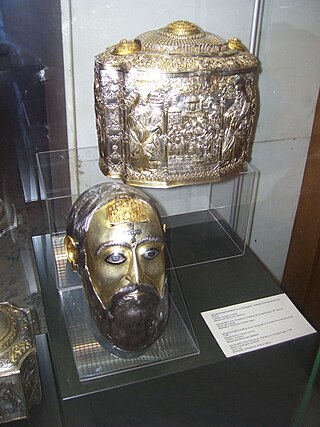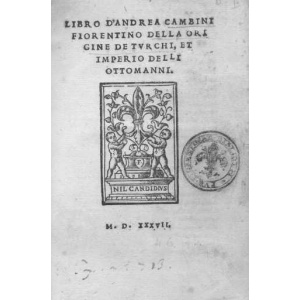
Mehmed II, commonly known as Mehmed the Conqueror, was twice the sultan of the Ottoman Empire from August 1444 to September 1446 and then later from February 1451 to May 1481.

Constantine XI Dragases Palaiologos or DragašPalaeologus was the last Byzantine emperor, reigning from 1449 until his death in battle at the Fall of Constantinople in 1453. Constantine's death marked the definitive end of the Eastern Roman Empire, which traced its origin to Constantine the Great's foundation of Constantinople as the Roman Empire's new capital in 330.

The fall of Constantinople, also known as the conquest of Constantinople, was the capture of the capital of the Byzantine Empire by the Ottoman Empire. The city was captured on 29 May 1453 as part of the culmination of a 55-day siege which had begun on 6 April.

The Walls of Constantinople are a series of defensive stone walls that have surrounded and protected the city of Constantinople since its founding as the new capital of the Roman Empire by Constantine the Great. With numerous additions and modifications during their history, they were the last great fortification system of antiquity, and one of the most complex and elaborate systems ever built.

The formal definition of large-calibre artillery used by the United Nations Register of Conventional Arms (UNROCA) is "guns, howitzers, artillery pieces, combining the characteristics of a gun, howitzer, mortar, or rocket, capable of engaging surface targets by delivering primarily indirect fire, with a calibre of 76.2 mm (3.00 in) and above". This definition, shared by the Arms Trade Treaty and the Treaty on Conventional Armed Forces in Europe, is updated from an earlier definition in United Nations General Assembly Resolution 46/36L, which set a threshold of 100 mm (3.9 in). Several grammatical changes were made to that latter in 1992 and the threshold was lowered in 2003 to yield the current definition, as endorsed by UN General Assembly Resolution 58/54.

Zaganos or Zagan Pasha was an Albanian Ottoman military commander, with the titles and ranks of kapudan pasha and the highest military rank, grand vizier, during the reign of Sultan Mehmed II "the Conqueror". Originally a Christian, who was conscripted and converted through the devşirme system, he became a Muslim and rose through the ranks of the janissaries. He became one of the prominent military commanders of Mehmed II and a lala – the sultan's advisor, mentor, tutor, councillor, protector, all at once. He removed his rival, the previous Grand Vizier Çandarlı Halil Pasha the Younger, amid the fall of Constantinople. He later served as the governor of Thessaly of Macedonia.
Loukas Notaras was a Byzantine Greek statesman who served as the last megas doux or grand Duke and the last mesazon of the Byzantine Empire, under emperors John VIII Palaiologos and Constantine XI Palaiologos.
Raphael I of Constantinople was Ecumenical Patriarch of Constantinople from 1475 to 1476.

The bombard is a type of cannon or mortar which was used throughout the Late Middle Ages and the early modern period. Bombards were mainly large calibre, muzzle-loading artillery pieces used during sieges to shoot round stone projectiles at the walls of enemy fortifications, enabling troops to break in. Most bombards were made of iron and used gunpowder to launch the projectiles. There are many examples of bombards, including Mons Meg, the Dardanelles Gun, and the handheld bombard.

The Dardanelles Gun or Great Bronze Gun is a 15th-century siege cannon, specifically a super-sized bombard, which saw action in the 1807 Dardanelles operation. It was built in 1464 by Ottoman military engineer Munir Ali and modelled after the Basilic, the bombard crafted by Orban that was used for the Ottoman siege of Constantinople in 1453.
Leonard of Chios, also called Leonardo Giustiniani, was a Greek scholar of the Dominican Order and Latin Archbishop of Mytilene, best known for his eye-witness account of the Fall of Constantinople in 1453, which is one of the main sources for the event.
The Tale on the Taking of Tsargrad is a late 15th-century Russian tale on the fall of Constantinople attributed to one Nestor Iskander.

The Pumhart von Steyr is a medieval large-calibre cannon from Styria, Austria, and the largest known wrought-iron bombard by caliber. It weighs around 8 t and has a length of more than 2.59 m. It was produced in the early 15th century and could fire, according to modern calculations, an 800 mm (31 in) stone ball weighing 690 kg (1,520 lb) to a distance of roughly 600 m (2,000 ft) after being loaded with 15 kg (33 lb) of gunpowder and set at an elevation of 10°.

Nicolò Barbaro, son of Marco, was a Venetian nobleman and author of an eyewitness account, written in Venetian vernacular, documenting the Ottoman siege and conquest of Byzantine Constantinople in 1453, also known as the Fall of Constantinople.

Dionysius I was Ecumenical Patriarch of Constantinople two times, from 1466 to 1471 and from 1488 to 1490. He is honoured as a saint in the Eastern Orthodox Church and his feast day is November 23.

Andrea Cambini or Andreas Cambinus (1445/1460—1527) was an Italian historian, humanist and writer.
Jacob Notaras, also erroneously called Isaac, was a Byzantine aristocrat who survived the fall of Constantinople in 1453. Having got attention of the Ottoman ruler Mehmed the Conqueror as an adolescent, he was confined to the seraglio until he escaped in 1460. He later became one of the leaders of the Byzantine diaspora in Italy.
Gabriele Trevisano was a Venetian commander, who participated on the losing side of the Fall of Constantinople in 1453, having joined the Byzantine Empire in its defence of its capital city against the Ottoman Empire.
Marios Philippides was an American historian who was Emeritus Professor in the Department of Classics at the University of Massachusetts-Amherst.












